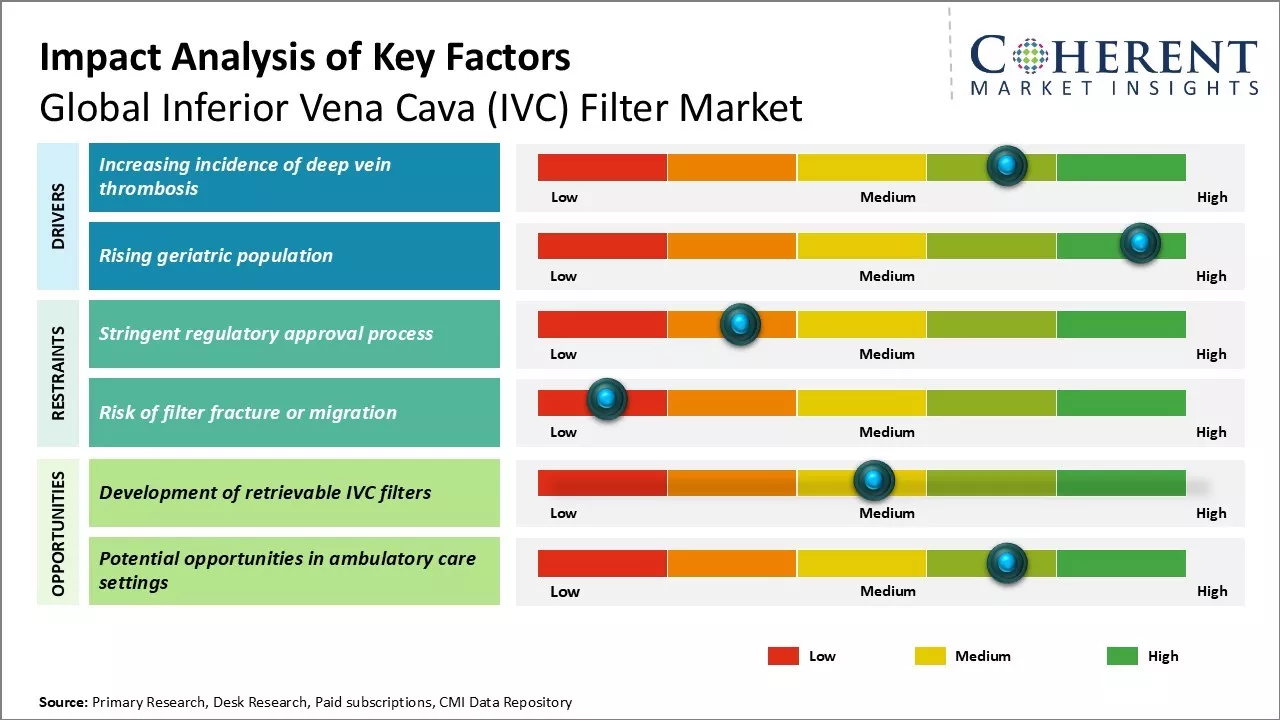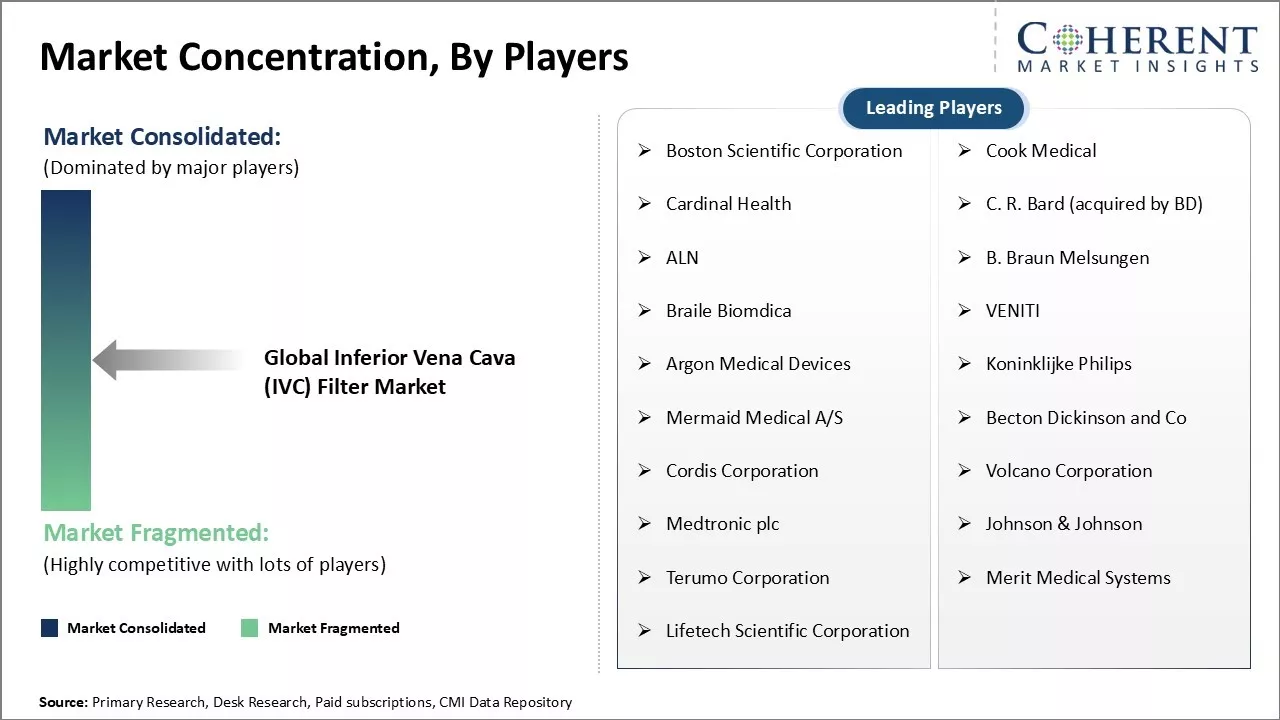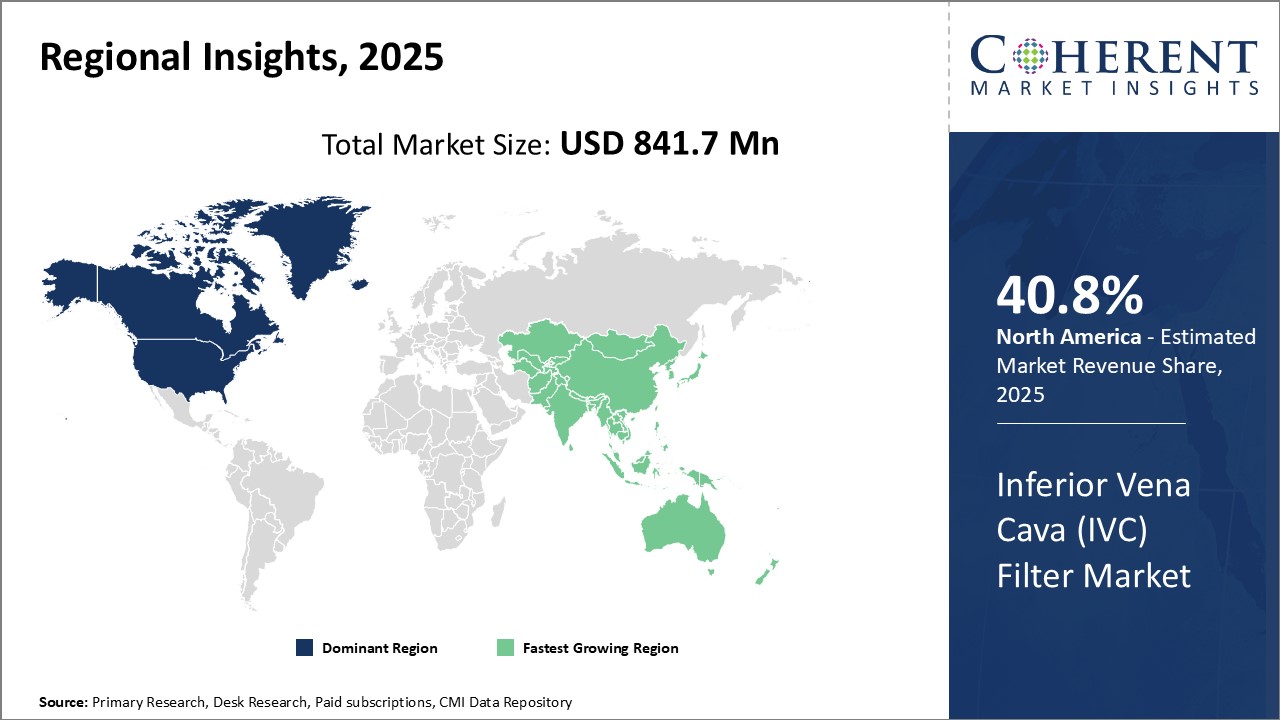Inferior Vena Cava (IVC) Filter Market Size and Trends
Global inferior vena cava (IVC) filter market is estimated to be valued at USD 841.7 Mn in 2025 and is expected to reach USD 1,539.6 Mn by 2032, exhibiting a compound annual growth rate (CAGR) of 9.0% from 2025 to 2032.

Discover market dynamics shaping the industry: Download Free Sample
The market growth is driven by growing prevalence of deep vein thrombosis and preference of minimally invasive procedures for its treatment. There has been rising demand for retrievable IVC filters due to associated risks of permanent IVC filters such as filter migration and fracture.
Market Driver - Increasing incidence of deep vein thrombosis
Rising incidence of deep vein thrombosis (DVT) can drive the market growth. As modern lifestyles become more sedentary with longer periods of immobility due to travel, binge watching or work commitments on computers and mobile devices, there has been increase in risk of developing blood clots in the leg veins. Prolonged sitting or lack of physical movement restricts normal blood flow and predisposes the formation of clots. With increasing stress levels, unhealthy diets and rising obesity rates, all of which are risk factors for DVT, more people are experiencing episodes of clots in the legs.
Rising caseload of DVT has further amplified in hospital settings. Patients undergoing complex surgeries or sustaining severe injuries that require long stays in bed are at high risk of developing this disease. With rapid growth in the number of surgical procedures being performed globally and better access to emergency care, there has been rise in incidences related to medical interventions. Elderly populations who tend to have limited mobility are especially vulnerable as are cancer patients undergoing chemotherapy. Growing cases of cancer, obesity and lifestyle diseases can trigger DVT.
These factors have resulted in a considerable rise in number of people diagnosed with DVT each year. As DVT needs to be aggressively managed to prevent its potentially life-threatening complication of pulmonary embolism, medical interventions have become crucial. When medications alone are insufficient due to high risk or recurring clots, insertion of inferior vena cava (IVC) filters has emerged as an important option. IVC filters are minimally invasive devices temporarily placed in the vena cava to trap blood clots entering the lungs. Rising prevalence of DVT can boost demand for alternate treatment avenues like IVC filters.
Market Concentration and Competitive Landscape

Get actionable strategies to beat competition: Download Free Sample
Rising geriatric population
The world population is aging at an unprecedented rate with people generally living longer due to advanced healthcare and lifestyle changes. It is estimated that by 2050, 1 in 6 people globally will be aged 65 years and above. This translates to an enormous expansion of the geriatric demographic worldwide with projections of over 2 billion senior citizens on the planet. As people grow older, their risk of developing chronic health issues rises in tandem. Things like reduced mobility due to arthritis or other age-related impairments curb normal activity levels considerably. The lack of movement coupled with other common comorbidities in the elderly population such as diabetes, heart disease and vascular conditions drastically raises their vulnerability to DVT.
Advanced age itself is considered a significant risk factor because aging diminishes circulatory function and speeds up blood coagulation. It becomes more difficult for the aging body to regulate normal blood flow and clotting tendencies within the leg veins. Therefore, just by virtue of living longer, elderly citizens have a higher probability of experiencing DVT at some point. Managing DVT in the geriatric group is challenging due to coexisting morbidities and healing capacities. Once DVT strikes, it is very common for seniors to suffer recurrences due to persistent pro-clotting tendencies. This makes IVC filters reliably effective alternatives when anti-coagulation alone is insufficient for the older population.
With lifetimes expanding worldwide, there will be increase in proportion of those aged 65 years and above requiring treatment for DVT and related conditions. Catering to the unique healthcare needs of this demographic can boost demand for specialized products like IVC filters. As people celebrate greater longevity, medical device markets must simultaneously address the complex health challenges of advanced age.
Key Takeaways from Analyst:
Global inferior vena cava (IVC) filter market growth is driven by rising incidence of deep vein thrombosis and pulmonary embolism around the world. As the risk of these conditions is higher in older populations, aging demographic in developed countries can offer growth opportunities. Hospitalizations due to rising obesity levels and lack of physical activity can also drive the market growth.
Stringent regulatory policies and recalls impacting certain product segments can hamper the market growth. Safety concerns over long-term risks associated with IVC filters can also hamper the market growth. The market also relies heavily on reimbursement policies which vary significantly globally.
Asia Pacific region will emerge as the fastest growing market due to growing medical tourism, increasing healthcare expenditures and developing healthcare infrastructure. Within Asia Pacific, China and India will be lucrative markets to tap due to their large patient populations and rapid economic growth. North America will dominate the market due to well-developed healthcare system and regional leaders manufacturing superior quality IVC filters.
Market Challenge - Stringent regulatory approval process
Key challenges faced by global inferior vena cava (IVC) filter market players include stringent regulatory approval process. The IVC filters are class III medical devices, which require rigorous clinical testing and pre-market approval from regulatory agencies such as the U.S. FDA and European Medicines Agency (EMA) before commercial launch. Getting regulatory approval is a complex, costly, and time-consuming process which involves clinical trials to demonstrate safety and efficacy of new IVC filters. Any changes to design, material or intended use requires additional studies and approvals. This often delays the launch of new and innovative IVC filter devices. The stringent norms also raise compliance requirements, which increase the overall costs for manufacturers. Complying with regulations across different markets also poses geographic expansion challenges for companies.
Market Opportunity: Development of retrievable IVC filters
Development of retrievable IVC filters presents lucrative growth opportunities for the market players. Unlike permanent filters which get embedded in the vein, retrievable filters can be inserted and then removed by a surgeon once the risk of a pulmonary embolism is over. This prevents long-term complications associated with permanent filters. There has been growing clinical evidence which shows potential benefits of retrievable filters over permanent ones. With increasing recognition of their advantages, there has been huge demand for retrievable IVC filters. Market players need to invest in R&D and clinical trials to develop advanced retrievable filters with improved clinical efficacy as well as features such as reduced risk of fracture or migration. Launching easy to retrieve and reposition filters will help companies gain more market share. For instance, in February 2023, Cook Medical secured FDA approval for its Celect Vena Cava Filter, a next-generation retrievable IVC filter. The Celect filter boasts enhanced flexibility and ease of insertion as compared to earlier models, along with a retrieval rate exceeding 90%.

Discover high revenue pocket segments and roadmap to it: Download Free Sample
By Product Type - Convenience and safety drives retrievable IVC filters segment growth
In terms of product type, retrievable IVC filters segment is estimated to contribute the highest market share of 59.7% in 2025, owing to their convenience and safety advantages over permanent filters. Retrievable filters can be removed from the body once the risk of a pulmonary embolism has reduced, often within three to six months. This provides clinicians with greater flexibility in patient treatment options. Not having to leave a medical device implanted long-term reduces device-related complications and risks to patient health. For patients, retrievable filters offer a less invasive solution as the filter will be removed after a short implantation period. This psychological benefit increases patient acceptance and preference for retrievable filters over permanent alternatives. Advancements in filter design have also improved the safety and ease of retrieval procedures. Newer generation retrievable filters feature enhanced capture capabilities and deliverability while maintaining structural integrity for simple removal. The non-permanent nature and clinical benefits of retrievable IVC filters have made them the preferred product choice among interventional radiologists and referring clinicians.
By Material- Superior performance of metal filters
In terms of material, metal segment is estimated to contribute the highest market share of 58.5% in 2025, due to their superior mechanical strength and performance. The vast majority of IVC filters currently in use are constructed out of various metal alloys like nitinol, stainless steel or titanium. These metals provide the optimal combination of flexibility, radio-opacity, and corrosion resistance and crush strength required for effective filter performance over long implantation periods. Metal filters can withstand the high pulsatile pressures of up to 2,000 mmHg exerted on the inferior vena cava wall without fracturing or showing signs of fatigue. Their shape memory allows metal filters to self-center and maintain tight apposition to the vessel wall. This increases capturing efficiency of potentially fatal pulmonary emboli and lowers the risk of filter migration or perforation into adjacent tissues. Advances in material science and manufacturing have made modern metal filters highly biocompatible as well. Metal remains the material of choice for inferior vena cava filters due to its unique mechanical properties best suited for the physiological filtering demands.
By Placement - Advantages of suprarenal IVC Filters
In terms of placement, suprarenal IVC filters segment is estimated to contribute the highest market share of 52.5% in 2025, due to distinct advantages these offer over infrarenal counterparts. Located just below the renal veins, suprarenal filters provide protection from pulmonary embolism in high-risk patients where thrombus may propagate upward towards the heart and lungs. Their placement above the entry points of the renal veins effectively traps clots that could potentially escape filtration by standard infrarenal filters. This increased capture area makes suprarenal filters particularly beneficial in patients with extensive deep vein thrombosis involving the iliac veins or proximal extent of thrombosis. Their atraumatic suprarenal deployment via transfemoral access also allows for safe recanalization of thrombus laden segments. Suprarenal filters are therefore reserved for scenarios at very high risk of pulmonary embolism where maximal protection is deemed necessary by clinicians. While associated with higher filter costs, their specialized placement confers unique benefits that continue to support usage growth in high-risk patient populations.
Regional Insights

Need a Different Region or Segment? Download Free Sample
North America dominates the global IVC filter market with an estimated market share of 40.8% in 2025. With some of the most prominent medical device companies headquartered in the U.S. and Canada, the region enjoys strong industry presence of global market leaders. These companies have large manufacturing facilities and invest heavily in R&D, allowing them to continually innovate and offer technologically advanced IVC filter products. Moreover, region has a highly developed healthcare infrastructure and widespread medical insurance which increases accessibility of expensive medical devices like IVC filters.
Favorable regulations and reimbursement environment can also drive the regional market growth. Stringent product approval processes ensure only high quality and safe filters enters the market. Favorable reimbursement policies also encourage higher adoption rates. The pricing flexibility allowed by regulators helps companies adjust their prices dynamically based on product features and technology. North America has a large pool of specialized clinicians and opinion leaders who influence buying decisions. Their access to latest research and training impacts the types of filters preferred.
Asia Pacific region has emerged as the fastest growing market for IVC filters. Rapid infrastructure development and growing medical needs of its massive population can boost demand. Countries like China and India offer attractive opportunities due to their huge patient pools and double increasing healthcare investments. Both governments are working to expand health insurances and make critical medical devices more affordable. This improves the region's ability to purchase and use premium IVC filters.
Many global firms see Asia as an important future market and have established local manufacturing and R&D centers. This allows for products tailored to regional needs at competitive prices. Moreover, local clinicians are getting more exposure to Western practices through international collaborations and conferences. As a result, Asia Pacific physicians are progressively adopting advanced IVC filters matching global standards. Their preferences continue shifting towards technologically superior brands available internationally.
Market Report Scope
Inferior Vena Cava (IVC) Filter Market Report Coverage
| Report Coverage | Details | ||
|---|---|---|---|
| Base Year: | 2024 | Market Size in 2025: | USD 841.7 Mn |
| Historical Data for: | 2020 To 2024 | Forecast Period: | 2025 To 2032 |
| Forecast Period 2025 to 2032 CAGR: | 9.0% | 2032 Value Projection: | USD 1,539.6 Mn |
| Geographies covered: |
|
||
| Segments covered: |
|
||
| Companies covered: |
Boston Scientific Corporation, Cook Medical, Cardinal Health, C. R. Bard (acquired by BD), ALN, B. Braun Melsungen, Braile Biomdica, VENITI, Argon Medical Devices, Koninklijke Philips, Mermaid Medical A/S, Becton Dickinson and Co, Cordis Corporation, Volcano Corporation, Medtronic plc, Johnson & Johnson, Terumo Corporation, Merit Medical Systems, and Lifetech Scientific Corporation |
||
| Growth Drivers: |
|
||
| Restraints & Challenges: |
|
||
Uncover macros and micros vetted on 75+ parameters: Get instant access to report
Inferior Vena Cava (IVC) Filter Industry News
- In May 2022, Argon Medical announced a partnership with Terumo India, a global leader in medical technology, to bring their products to the Indian market and offer comprehensive solutions for interventional radiology, vascular surgery, interventional cardiology, and clinical oncology
- In December 2021, the U.S. Food and Drug Administration had authorized the marketing of the Philips CavaClear Laser Sheath, the first laser-based device for removing inferior vena cava (IVC) filters. This device is designed to assist in detaching IVC filters, which are used to capture blood clots, when previous removal methods have failed.
- In July 2021, Royal Philips announced that the FDA had granted Breakthrough Device Designation for its laser-assisted device to remove inferior vena cava (IVC) filters when previous methods fail. IVC filters, used to prevent blood clots from reaching the heart or lungs, can pose long-term risks, prompting the FDA to recommend their removal when no longer needed.
*Definition- Global inferior vena cava (IVC) filter market consists of medical devices that are implanted in the inferior vena cava to prevent life-threatening pulmonary embolisms. IVC filters trap blood clots before they can reach the lungs. Key types include retrievable IVC filters and permanent IVC filters. The market has witnessed growth due to rising incidence of deep vein thrombosis and pulmonary embolism.
Market Segmentation
- Product Type Insights (Revenue, USD Mn, 2020 - 2032)
-
- Retrievable IVC Filters
- Permanent IVC Filters
- Material Insights (Revenue, USD Mn, 2020 - 2032)
-
- Metal
- Non-Metal
- Placement Insights (Revenue, USD Mn, 2020 - 2032)
-
- Suprarenal IVC Filters
- Infrarenal IVC Filters
- Application Insights (Revenue, USD Mn, 2020 - 2032)
-
- Deep Vein Thrombosis
- Pulmonary Embolism
- Trauma and Surgical Procedures
- Others
- End User Insights (Revenue, USD Mn, 2020 - 2032)
-
- Hospitals
- Ambulatory Surgical Centers
- Specialty Clinics
- Others
- Regional Insights (Revenue, USD Mn 2020 - 2032)
-
- North America
- U.S.
- Canada
- Latin America
- Brazil
- Argentina
- Mexico
- Rest of Latin America
- Europe
- Germany
- U.K.
- Spain
- France
- Italy
- Russia
- Rest of Europe
- Asia Pacific
- China
- India
- Japan
- Australia
- South Korea
- ASEAN
- Rest of Asia Pacific
- Middle East
- GCC Countries
- Israel
- Rest of Middle East
- Africa
- South Africa
- North Africa
- Central Africa
- North America
- Key Players Insights
- Boston Scientific Corporation
- Cook Medical
- Cardinal Health
- C.R. Bard (acquired by BD)
- ALN
- Braun Melsungen
- Braile Biomdica
- VENITI
- Argon Medical Devices
- Koninklijke Philips
- Mermaid Medical A/S
- Becton Dickinson and Co
- Cordis Corporation
- Volcano Corporation
- Medtronic plc
- Johnson & Johnson
- Terumo Corporation
- Merit Medical Systems
- Lifetech Scientific Corporation
Share
Share
About Author
Komal Dighe is a Management Consultant with over 8 years of experience in market research and consulting. She excels in managing and delivering high-quality insights and solutions in Health-tech Consulting reports. Her expertise encompasses conducting both primary and secondary research, effectively addressing client requirements, and excelling in market estimation and forecast. Her comprehensive approach ensures that clients receive thorough and accurate analyses, enabling them to make informed decisions and capitalize on market opportunities.
Missing comfort of reading report in your local language? Find your preferred language :
Transform your Strategy with Exclusive Trending Reports :
Frequently Asked Questions
EXISTING CLIENTELE
Joining thousands of companies around the world committed to making the Excellent Business Solutions.
View All Our Clients
